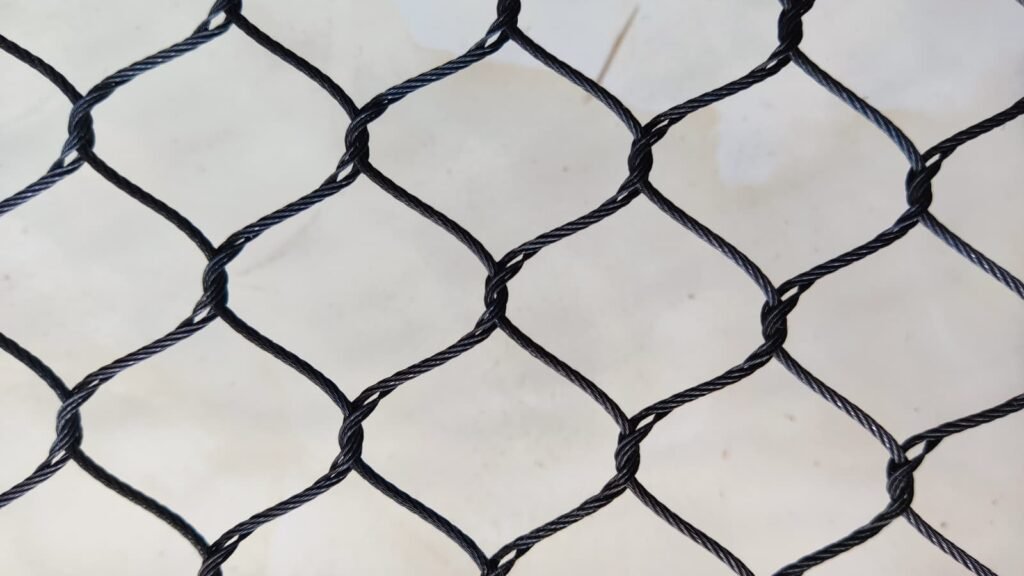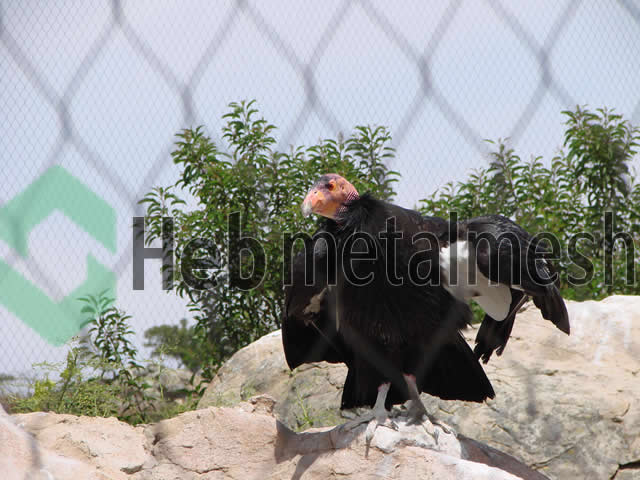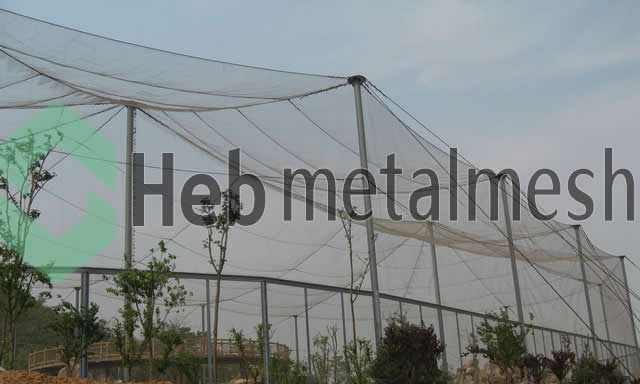Introduction to Animal Stock Fencing
Animal stock fencing plays a crucial role in safeguarding livestock and maintaining effective farm management. Throughout history, farmers have recognized the necessity of properly enclosing their animals to prevent them from wandering off or becoming prey to predators. The evolution of fencing materials and methods has given rise to advanced solutions tailored to meet various farming needs, enhancing both security and safety for livestock.
Hebmetalmesh is a prominent manufacturer that specializes in producing flexible handwoven stainless steel netting panels and rolls, specifically designed for animal stock fencing. Their innovative designs ensure that livestock is securely contained, thereby reducing the risk of accidents, injuries, or losses. With its high durability and resistance to environmental factors, stainless steel netting is an excellent material choice for long-lasting animal stock fencing.
The importance of animal stock fencing extends beyond mere animal containment. Effective fencing can also facilitate better herd management by enabling farmers to effectively rotate grazing areas, protecting valuable pastureland from overgrazing. Moreover, secure fencing systems deter potential intruders, whether they are wild animals or unauthorized individuals, thus contributing to the overall security of the farm and its assets.
In addition, animal stock fencing can help farmers comply with regulations governing animal welfare. Ensuring that livestock are kept in a humane environment is imperative to maintaining the health and well-being of the animals. A sturdy and well-constructed fencing solution minimizes stress and promotes a healthier living condition, which is essential in modern agricultural practices.
To summarize, animal stock fencing is not merely a physical boundary; it is an integral part of responsible livestock management. Companies like Hebmetalmesh are at the forefront of providing reliable fencing solutions that meet the complex demands of today’s agricultural landscape, ensuring the safety and security of livestock while promoting effective farm management strategies.
Key Features of Hebmetalmesh Products
Hebmetalmesh has established a prominent position in the animal stock fencing industry with its commitment to quality and innovation. One of the standout features of their animal fence panels is the use of high-quality stainless steel. This material is essential for ensuring durability and resistance to harsh environmental conditions, which are often encountered in agricultural settings. Unlike traditional fencing options that may corrode over time, stainless steel retains its strength and aesthetic appeal, making it a wise investment for livestock protection.
In addition to the robust material selection, Hebmetalmesh offers a choice of finishes for their fencing products. Customers can select from a natural color or a black oxide finish, allowing them to tailor their fencing to either blend in with the surrounding environment or make a distinct statement on the property. This customization not only enhances the visual appeal of the fence but also contributes to its functionality, as different finishes can provide varying levels of rust resistance and longevity.
The incredible experience of Hebmetalmesh, spanning over 30 years, further bolsters the reliability of their animal fencing solutions. With decades of industry knowledge, they have developed a keen understanding of the specific needs of livestock owners and what is required for effective fencing. This expertise translates into products that not only meet but often exceed industry standards, ensuring that their animal stock fencing solutions provide enhanced security and peace of mind for farmers and ranchers alike.
By prioritizing quality materials and leveraging extensive experience, Hebmetalmesh sets itself apart as a leading manufacturer of animal fencing solutions. Their commitment to excellence assures customers that they are investing in superior products designed to safeguard their livestock effectively.
Best Type of Woven Wire Stock Fencing for Beef Cattle
When considering the best type of woven wire stock fencing for beef cattle, several factors must be taken into account, particularly when the pasture is hilly and uneven. The primary purpose of fencing in such environments is to ensure that the cattle remain securely contained while also allowing flexibility to adapt to the landscape. Woven wire fencing, known for its durability and strength, is often considered the ideal choice for this application.
One of the key characteristics of effective woven wire stock fencing is its ability to withstand both the physical pressure exerted by large animals and the forces of nature, such as wind and rain. The foundation of this type of fencing usually consists of high-tensile wire, which not only provides enhanced strength but also reduces the likelihood of sagging over time. This is particularly important in hilly pastures where the terrain can exert varying levels of strain on the fencing material.
Moreover, it is important to select woven wire that features a combination of vertical and horizontal wires, as this design enhances the integrity of the entire fencing structure. Given that beef cattle can weigh over a thousand pounds, using a fencing system that is both robust and flexible is paramount to accommodating their movements in rough terrain. Additionally, utilizing fencing that includes barbed wire at the top can deter predators and prevent cattle from jumping over the fence.
In conclusion, when selecting the best woven wire stock fencing for beef cattle in a hilly pasture, prioritize materials that offer strength, flexibility, and a design tailored to withstand the rugged landscape. Such characteristics not only guarantee the security and safety of livestock but also contribute to long-lasting fencing solutions that can adapt to environmental challenges over time.
Comparing 12.5 Gauge vs 14 Gauge High-Tensile Electric Fencing for Sheep and Goats
When considering animal stock fencing options for smaller and more agile livestock such as sheep and goats, the choice between 12.5 gauge and 14 gauge high-tensile electric fencing is a crucial decision. Both gauges offer distinct benefits and characteristics that can influence their effectiveness in containing these animals. The primary difference lies in the thickness of the wire and the resulting strength and durability of the fencing system.
12.5 gauge wire is thicker compared to 14 gauge, which translates to a higher tensile strength. This added strength makes the 12.5 gauge fencing more resistant to deformation and provides greater longevity, especially in environments where animals may exert significant pressure against the fence. Furthermore, its robustness can be particularly beneficial when containing an active flock of sheep or a herd of goats, which may test the boundaries of their enclosure. The increased strength also means that less frequent repairs or replacements are needed, resulting in lower long-term costs.
On the other hand, 14 gauge high-tensile fencing is lighter and easier to handle, making installation simpler and often faster. This can be a compelling factor for farmers and ranchers who need to establish new fencing quickly. While it is not as strong as the 12.5 gauge option, it still provides adequate containment for sheep and goats, particularly in areas where they are less likely to challenge the fence aggressively. Moreover, 14 gauge fencing can be more economical, which may appeal to those with budget constraints.
When implementing electric fencing, both gauges can enhance control over livestock movement. The addition of electrical components can deter animals from attempting to breach the barriers, providing an extra layer of security. Ultimately, the decision should be based on specific needs, considering the local environment, livestock behavior, and budgetary constraints to ensure optimal animal stock fencing solutions.
Cost Considerations for Non-Climb Horse Fencing
When contemplating the installation of animal stock fencing, particularly non-climb horse fencing, it is essential to consider various cost factors. This type of fencing is designed specifically to safeguard horses by preventing climbing and entrapment, making it a popular choice among livestock owners. A common configuration for non-climb horse fencing includes a 330-foot roll with 3 x 3 inch openings, which serves as a reliable barrier against potential dangers.
As of October 2023, the average price for a 330-foot roll of non-climb horse fencing generally ranges between $300 to $600. The cost can fluctuate based on materials used, brand reputation, and regional pricing variations. Traditional options such as galvanized steel or woven wire may be more cost-effective; however, premium materials, such as vinyl-coated fencing, could increase the overall budget. Those seeking higher durability and more aesthetic appeal may find that the upfront investment in quality materials, while more expensive, could yield long-term savings through reduced maintenance and replacement needs.
Moreover, it is essential to consider additional costs such as installation, which can vary depending on whether the fencing is set up as a DIY project or professionally installed. Hiring professionals generally incurs labor costs ranging from $1 to $3 per foot, adding up to an additional $330 to $990 for a full 330-foot enclosure. Budget-conscious consumers should also account for supplementary items such as posts, gates, and hardware, which can increase overall expenditure. Therefore, when budgeting for non-climb horse fencing, it is crucial to examine not only the initial purchase price but also the long-term value and benefits associated with superior protection and safety for livestock.
Proper Installation Techniques for Barbed Wire Stock Fencing
Installing barbed wire stock fencing effectively is crucial for maintaining the safety and security of livestock. The right techniques ensure that the fencing remains taut and durable over time. To begin with, gather the necessary tools, including a tractor, post drivers, wire cutters, and gloves. Identifying the location for the fence is important; this stage may involve marking out the perimeter using stakes or flags to visualize the layout.
Next, set the corner and end posts first. Using a post driver, drive the posts into the ground at a consistent depth, ensuring they are plumb and directly aligned. Corner posts require extra attention; they should be thicker and more robust than inline posts to withstand additional tension from the barbed wire. After the end and corner posts are secured, proceed to install the inline posts at regular intervals, typically 8 to 12 feet apart, depending on the terrain and specific requirements for the animal stock fencing.
Once the posts are in place, extend the barbed wire between them. When handling barbed wire, wear protective gloves to prevent injuries. Attach the wire securely to the posts using fencing staples or wire ties, which should be situated approximately 6-8 inches apart. To maintain optimal tension in the wire, use the tractor to pull the wire tight while ensuring that the barbed components are facing outward, providing an effective barrier for livestock.
During installation, it’s essential to avoid common errors such as failing to stretch the wire appropriately or not securing the wire sufficiently at the corners. Regularly check the tension as you progress and readjust as needed. Upon completing the installation, thoroughly inspect the entire fence for any weak points or gaps. A well-installed barbed wire stock fencing not only enhances safety but also ensures the longevity of the barrier, providing peace of mind for livestock owners.
Durability of Galvanized Stock Fencing Options
When considering animal stock fencing, durability plays a pivotal role in safeguarding livestock and minimizing replacement costs. Galvanized stock fencing has emerged as a prominent option due to its resistance to corrosion and long-lasting performance. At the core of its durability is the use of high-quality galvanized steel, which undergoes a galvanization process that coats the steel with zinc. This layer significantly extends the lifespan of the fencing, making it an excellent investment for farmers and ranchers.
Several types of galvanized stock fencing designs are available that enhance their overall strength and durability. Among these, woven wire fencing stands out, offering a strong structure that can withstand various environmental factors. Its design features tightly interwoven wires that provide not only sturdiness but also flexibility, allowing it to adapt to the movement and pressures exerted by livestock. Furthermore, the spacing between wires can be adjusted to cater to specific animal sizes, making this fencing a versatile choice.
Another durable option includes barbed wire fencing, which combines galvanized steel wires with sharp barbs at intervals. This fencing deters animals from attempting to escape or intruders from gaining access, while maintaining a sturdy structure that resists environmental wear. Farmers often prefer this option for its effectiveness in high-security applications. Regular maintenance of galvanized stock fencing is crucial to prolonging its lifespan further. Routine inspections and the removal of debris can help stave off corrosion and structural deterioration, ensuring the fencing remains functional for years to come.
In conclusion, selecting the right galvanized stock fencing can significantly impact the safety and longevity of your livestock management. By investing in quality materials and incorporating effective maintenance practices, farmers can achieve a secure environment that protects their valuable animals. Opting for durable galvanized fencing options ensures not only the immediate safety of livestock but also long-term economic savings.
Conclusion: Making Informed Decisions for Your Livestock
In navigating the complexities of animal stock fencing, several critical factors emerge that can significantly impact the well-being of your livestock. A careful selection of fencing solutions ensures not only the security of the animals but also aids in the comprehensive management of agricultural operations. Understanding the diverse types of fencing materials and their respective functionalities is vital; whether opting for high-tensile wire, welded wire, or electric fencing, each serves a unique purpose tailored to specific livestock requirements.
Additionally, evaluating the design and layout of your fencing system is equally important. Adequate height, spacing, and visibility can deter predators while ensuring that the livestock remain safe and secure. Electric fencing, for instance, serves a dual purpose of confinement while acting as a deterrent against potential threats. It is essential to consider the breed and temperament of your livestock when determining which fencing solution will best suit their needs.
Moreover, budget constraints are a reality for many farmers and ranchers, making it crucial to find a balance between cost and quality. Investing in durable and low-maintenance materials can lead to significant long-term savings and is a prudent approach to livestock management. Thorough research and consultation with experts, such as those at Hebmetalmesh, can provide invaluable insights into the best fencing options available within your budget.
As you make decisions regarding animal stock fencing, remain mindful of your specific circumstances and operational goals. By prioritizing reliability, functionality, and safety, you can ensure a secure environment for your livestock, ultimately contributing to the successful management of your farming or ranching endeavors.
FAQs About Animal Stock Fencing
Animal stock fencing plays a crucial role in safeguarding livestock and ensuring their well-being. As many individuals may have questions regarding the selection and maintenance of this essential infrastructure, we have compiled a list of frequently asked questions to assist both novice and experienced livestock owners.
What materials are best for animal stock fencing?
When selecting materials for animal stock fencing, consider options such as wooden, wire, or composite fencing. Wooden fencing offers durability and aesthetic value, while wire fencing, such as barbed or high-tensile options, provides flexibility and strength. Composite fencing combines various materials to achieve longevity and minimal maintenance. Each material has its unique advantages, so it is essential to assess the specific needs of the livestock and the environment.
How do I properly install animal stock fencing?
Proper installation of animal stock fencing is paramount in ensuring its effectiveness. Start by clearing the area of debris and measuring the perimeter accurately. Set posts at regular intervals, ensuring they are firmly anchored in the ground. If using wire fencing, attach the wire securely to the posts, maintaining proper tension to prevent sagging. It is advisable to follow manufacturer recommendations for installation, particularly regarding specific livestock needs, to enhance protection.
What are the best practices for maintaining my fencing?
Regular maintenance of your animal stock fencing will extend its lifespan and efficiency. Periodically inspect the entire fence for any damage or wear and promptly repair any breaches. Remove vegetation that may encroach upon the fence line. Additionally, ensure that gates are functioning correctly and securely latch to prevent escapes. In regions affected by extreme weather conditions, it may be necessary to conduct more frequent checks to address any potential challenges posed by environmental factors.
By addressing these common inquiries, we hope to empower livestock owners with the knowledge to make informed decisions regarding their animal stock fencing. Understanding material options, installation methods, and maintenance practices is essential to create a secure environment for your animals.
FAQs
A1: Stainless steel provides superior strength and rust resistance, offering a durable, long-lasting, and low-maintenance heavy-duty stainless steel animal stock fencing solution for confining livestock and other animals.
A2: Yes. We provide custom-sized livestock fencing rolls to meet the specific requirements of your pasture, ensuring efficient and secure installation for any perimeter.
A3: Absolutely. Our panels feature smooth, rigid construction, creating a safe and sturdy fencing for horses and cattle that prevents injury and withstands heavy pressure.
A4: The black oxide animal stock fencing offers a sleek, low-glare appearance that is visually subtle in rural settings while maintaining the same exceptional durability and weather resistance.
A5: Hebmetalmesh stainless steel material is highly corrosion-resistant, making it an ideal weather-resistant livestock fencing capable of enduring rain, snow, and sun for years without deteriorating.


